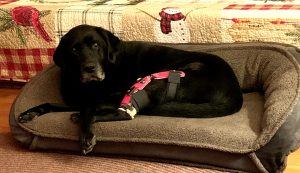
Amy Rosenthal
My Pet's Brace Practitioner
The Patient: Sophie, a 12-year-old, 78-pound Labrador retriever with a torn CCL in the left rear leg
Case of Interest: For the past 10 years, we’ve seen clinically that our custom knee braces for Cranial Cruciate Ligament injuries work effectively. However, very little scientific research has been conducted on bracing as an alternative to CCL surgery. We at My Pet’s Brace are currently conducting the most extensive comprehensive research on bracing with a GaitMat with plans to publish the data in mid-2021. Sophie was one of the subjects in the study.
Diagnostic History: Sophie was playing on a slight hill in March 2018. She yelped and began non-weight-bearing on her rear left leg. She was brought to the veterinarian and was diagnosed with a CCL tear. The owners tried rest and medication, but there was no progress a year after the injury. The owners then made the decision to pursue a brace due to her age and lack of progress.
Sophie was evaluated and cast at our Morgantown, PA facility. She was fitted with her brace in May of 2019. It was also at this appointment that it was decided that she was a candidate for our Stifle Brace Outcome Study. Candidates for the study were required to have a CCL injury, be 7-12 years old, weigh 24-100 pounds, be able to walk on a leash in a straight line and have no other leg injuries (past or current).
Sophie walked on a 12-foot pressure-mat with 18,432 sensors which measure the pressure per footfall. Sophie walked up and down the mat three or four times to ensure a good steady walk. She did this once without the brace and then with the brace to compare how much pressure she was putting on her injured leg immediately after donning the brace.
Follow-Ups: Sophie was then seen three-weeks, four-months and eight-months after delivery. At each of these appointments, the fit of the brace was examined and she walked on the pressure mat. Her walks were compared to previous walks to analyze her progress.
The GaitMat software analyzes the data from the pressure mat and runs it through an algorithm. This algorithm takes into account breed, pressure, and expected pressure on each limb and generates a number that encompasses all of that data. This number is called the Gait4Dog Lameness Score (GLS score) and is normalized to 100 for each leg. Therefore, a healthy dog would have a GLS score of 100 for each of their four legs.
By her 8-month checkup, her GLS score improved by over 250%. Sophie no longer wears her brace. She is enjoying senior life and looks forward to what her family calls “stroll and sniff” walks.


